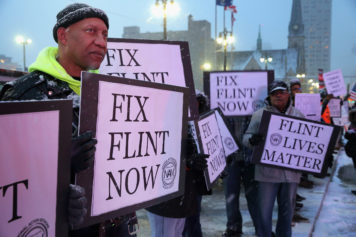On Sunday night, the Democratic candidates for president were in Flint, Michigan for the latest debate. At the CNN-sponsored event, Hillary Clinton and Bernie Sanders addressed race, economic inequality, gun violence, other domestic issues, and of course, the Flint water crisis.
It was the type of debate one would be hard-pressed to find among the Republican field, with a breadth of questioning and hard issues that reflected the gravity of the crisis facing Flint. According to Yoni Appelbaum at The Atlantic, the people of Flint won the debate. Flint residents whose families were poisoned by lead and affected by gun violence addressed the candidates and asked what they would do to solve these problems.
“But Sunday night’s debate was also a powerful reminder of the purposes of politics. It was held in a city already devastated by the loss of jobs, and now victim to catastrophic failures of governance at every level,” Appelbaum wrote. “As local residents stepped up to ask their own questions of the candidates, they spelled out the stakes of this election in deeply personal terms, grounding the debates over abstract principles in the questions with which their communities are struggling.”
Both Sanders and Clinton said that Michigan Gov. Rick Snyder should resign. But Snyder — faulted for his callousness and lack of leadership in allowing Flint residents to suffer from lead poisoning — had time to Tweet during the debate, even if he had no time to help poor Black children. As the Washington Post reported, while the Democratic candidates condemned the state government for its failure and incompetence, Snyder defended himself on social media — deflecting blame, touting his supposed successes, and even pointing to the Detroit comeback as a success story.
In a few days, political candidates will be leaving #Flint and Michigan. I am committed to the people of Flint. https://t.co/lejBrxwhIi
— Governor Rick Snyder (@onetoughnerd) March 7, 2016
There are many questions about the #FlintWater crisis. Get the facts & learn how we’re working to move #FlintFWD pic.twitter.com/jxVaFv4vne
— Governor Rick Snyder (@onetoughnerd) March 7, 2016
This was never about money. This was a failure of government at all levels that could be described as a massive error of bureaucracy.
— Governor Rick Snyder (@onetoughnerd) March 7, 2016
I’ve proposed more than $230 million in additional aid for Flint, and have already delivered $70 million #FlintFWD
— Governor Rick Snyder (@onetoughnerd) March 7, 2016
Since taking office in Jan. 2011, there has been an increase of 440,000 new private sector jobs in #Michigan.
— Governor Rick Snyder (@onetoughnerd) March 7, 2016
Detroit is stronger than it has been in decades. We came together to pass the bipartisan Grand Bargain & help Detroit’s families
— Governor Rick Snyder (@onetoughnerd) March 7, 2016
Meanwhile, as the people of Flint have suffered, the public school students of Detroit have suffered as well under the same neocolonial emergency manager system. Detroit was a topic of discussion in the debate, as the city’s public schools are plagued with vermin, black mold, and crumbling, freezing and boiling-hot buildings. The Detroit Federation of Teachers filed a lawsuit forcing the emergency manager to resign and to return control of the schools to an elected school board, as People’s World reported. There has been a dramatic downward shift for a city whose workers were once among the highest paid in the nation. Sanders blamed Detroit’s woes on free trade and years of ignoring problems, as factories left the city and red-lining trapped Black workers. Clinton articulated a wide-ranging manufacturing plan, but did not say whether it would restore auto industry jobs.
As was reported in The Los Angeles Times, a man-made disaster unraveled in Flint, all within plain sight of water regulators. Two years ago, then-Mayor Dayne Walling and other officials toasted to glasses of water, in celebration of the decision by the state-appointed emergency manager to switch the city’s water source. The decision to use the Flint River, rather than Detroit as Flint’s water source, was a cost-cutting measure. Even General Motors had refused to use the Flint River because the high levels of chloride corroded their metal auto parts. Meanwhile, the federal Environmental Protection Agency asked the state Department of Environmental Quality if it had an anti-corrosion plan to stop the leaching of lead from the pipes into the drinking water. Resistant to the notion that Flint residents were suffering from lead poisoning, the state agency lied and said it was undertaking anti-corrosion measures. However, a turning point came when a task force appointed by Snyder blamed the DEQ for the lead poisoning, and having a “minimalist approach to regulatory and oversight responsibility” that was “unacceptable and simply insufficient to the task of public protection.”
Despite all of this, Flint’s poisonous water is the most expensive in the nation according, to the Washington Post. An annual water bill of $864 for a Flint resident is more than twice the state average, far higher than the national average of $500, and ten times higher than Phoenix, which is in the desert and not surrounded by the Great Lakes, as is Michigan. Further, according to the Post, the water in Flint is far above the threshold of affordability established by the United Nations. Water and sewer bills in that economically depressed city account for 7 percent of household income, double the U.N. guideline.
Although Flint has received a great deal of attention for its lead poisoning crisis, as it should, other cities are similarly suffering. As The New York Times reported, Cleveland, Ohio, has experienced its own lead crisis, not due to the drinking water, but rather “because a decades-long attack on lead in household paint has faltered. It is a tragic reminder that one of the great public health crusades of the 20th century remains unfinished.”
The Times noted that while up to 7 percent of children in Flint have had elevated levels of lead in their blood, in Cleveland that number is 14.2 percent. Further, while an estimated 7.7 percent of Black children under 6 throughout the nation had blood lead levels above five micrograms per deciliter — which is considered elevated — in Cleveland’s Glenville neighborhood, 26.5 percent of children — 286 children — exceeded that threshold in 2014. Moreover, two children registered at over 45 micrograms, a level requiring hospitalization to remove lead from the body.
While the nation declared a war on lead, a neurotoxin that compromises childhood development, that war has abated. Despite the efforts to eliminate lead in paint, gasoline and to someday eradicate childhood lead poisoning, the malady is a fact of life in cities throughout the country — particularly among poor neighborhoods that lack political clout.
There are around 37 million homes and apartments still containing lead paint, according to The Times, and 23 million with potentially hazardous lead levels in the soil, paint chips or household dust. Approximately 4 million children live in the most at-risk households. And in Atlantic City, Philadelphia and Allentown, Pa., a half-million children — or 23.1 percent — have lead levels so high that they require medical attention. And one study in Chicago attributed 15 percent of failing grades in reading and math to lead poisoning.



